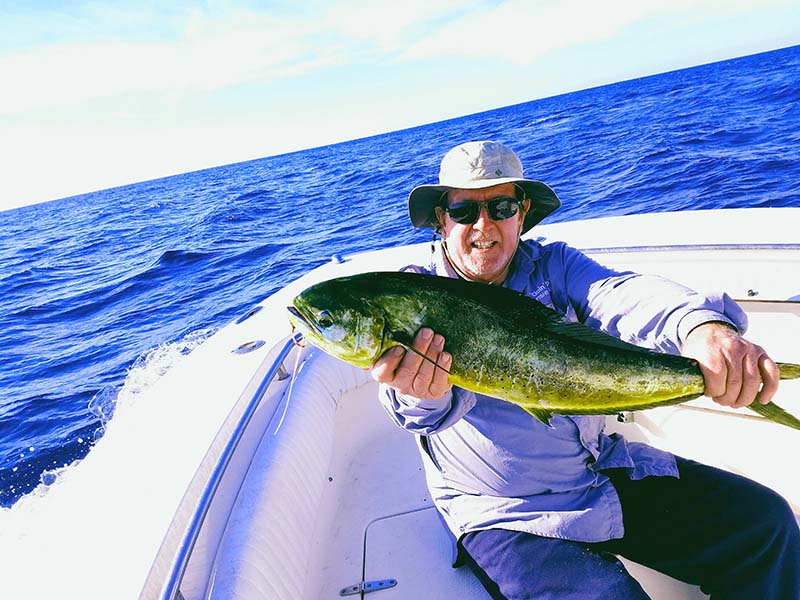
March = cobia! With cooling water temperatures that have moved into our area, cobia will also be coming into the waters off the Treasure Coast. When the weather allows and you can get outside the inlets, it is a great time to target cobia. Cobia is an awesome fighting fish and one of the best tasting fish in the ocean. These fish will be found from just off the beach on out to 80 to 90 feet depths.
There are various ways to find cobia. They follow manta rays, swim behind turtles, and swim with sharks or with bait schools. On days with westerly winds, or if there are days with light to no wind, you will be able to sight fish cobia. Look for manta rays or turtles and cast behind them to see if there are any cobia following them. I recommend having someone stand at the highest point on the boat (that is safe) to be your lookout for these fish. I like to have some live bait, if possible, in the water as I am searching for the manta rays. There could always be a chance for a cobia to be away from the manta rays and find your bait to his preference.
You can run the beach on calmer days looking for schools of sharks. When sharks are found, scan the area to see if any cobia can be seen mixed in with the sharks. Whether you locate a cobia or not, cast a 2 to 2.5-ounce jig, preferably with a tail on it, or an eel like jig past the school of sharks and work it back to the boat. This will catch the attention of any cobia, since eels are a favorite food of cobia. Cobia will check out the jig and many times hit it. If they don’t eat the jig, they will often follow it back to the boat. In this instance, have another rod ready and rigged with live bait or a whole squid to toss at the cobia to entice it to eat.
Cobia can also be caught while bottom fishing. They are a curious fish. They will swim right up to your boat to check it out. While bottom fishing, always have a rod rigged with a bait or jig in case a cobia shows up and always keep an eye on the water.
I recommend using a 7-foot rod with a good backbone. The length of the rod will help on casting a lure farther to the fish and the backbone will help for the fight. I would recommend a 6000 to 8000 sized reel spooled with at least 30-pound braid and a 50-pound leader with a 6/0 live bait or circle hook. On our coast, cobia can range up to 50 to 60 pounds and the chance of a bigger one is always there. You will want tackle to handle the big one that may be around.
When you catch a cobia and get it boatside, if you are not sure that it is legal size, it is best to use a net to land it so you can release the fish unharmed if it is too short. Also, if at all possible, use a net to land even a legal fish, it will be just a little bit more calm when landed. Be careful after landing these fish because they are powerful, they can destroy anything and everything in the cockpit. The best bet is to get them on ice in the cooler or fishbox and the lid locked down as soon as possible. Also, be careful of the spines on a cobia’s back between the heads and dorsal fin. They are very sharp and covered with bacteria from the slime and can cause a painful puncture through your skin.
On your days on the water that cobia can’t be found, the bottom bite will still be on. A variety of snapper, seabass and porgy will be looking for a meal. Head out to a reef or wreck and drop a cut bait or squid to the bottom for a day of fun. Remember to review your size and bag limits. Have fun and tight lines!
FORECAST BY: Capt. Danny Markowski
LottaBull Fishing Charters
Phone: (772) 370-8329
Email: lottabull4@bellsouth.net
www.lottabullfishingcharters.com
Cobia: Rachycentron canadum
Appearance:
- Long, slim fish with a broad depressed head
- The lower jaw protrudes past the upper jaw
- Dark lateral stripe extends through the eye to the tail
- First dorsal fin has 7 to 9 free spines
- When young, has conspicuous alternating black and white horizontal stripes
Habitat:
Cobia are found in nearshore and inshore waters with inlets and bays. Cobia are frequently found around buoys, pilings and wrecks in these areas.
Behavior:
They spawn in spring and early summer.
Additional Information
State Record: 130 lb 1 oz, caught near Destin
Fishing Tips and Facts: Live crabs and small fish are good baits for cobia. Keep bait near the surface or, if cobia are deeper, add just enough weight to get the bait down and still retain its movement. Medium to heavy tackle is required to land these fish which average 30 pounds. Large specimens in the 50-80 pound class are frequently caught and cherished by the lucky angler who outmatches these powerful fish. Cobia are excellent table fare.
Image Credit: © Diane Rome Peebles | Cobia info: MyFWC.com





